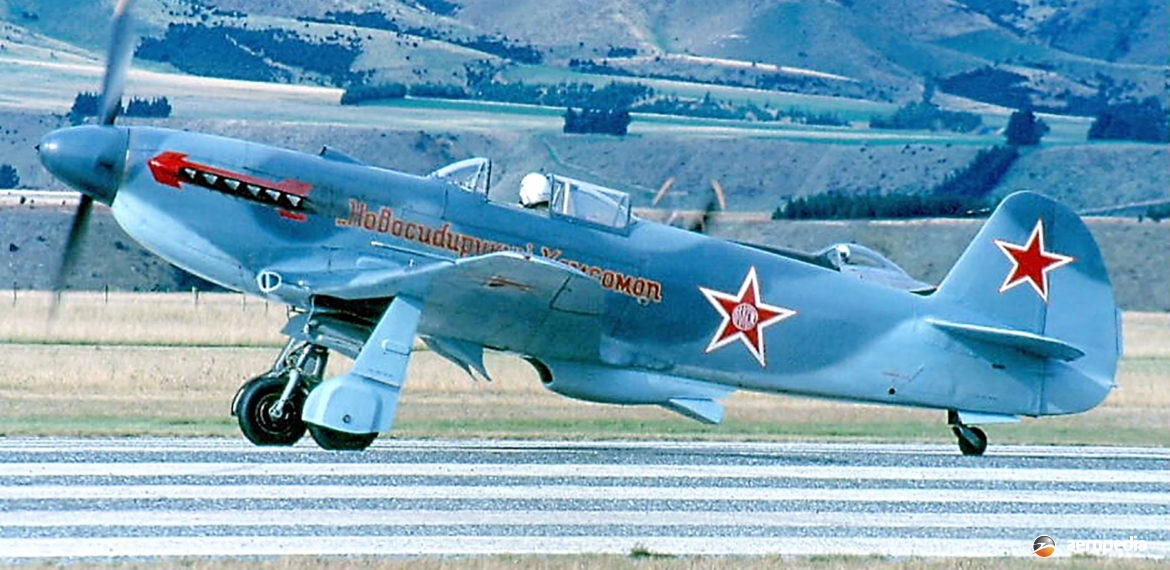Photograph:
Yak 3M ZK-YAK (c/n 0470102) at Wanaka, New Zealand in 1996 (David C Eyre)
Country of origin:
Union of Soviet Socialist Republics
Description:
Single-seat close-support fighter
Power Plant:
One 914 kw (1,225 hp) Klimov VK-105PF-2 twelve-cylinder VEE liquid-cooled engine
Specifications:
- Wingspan: 9.20 m (30 ft 2¼ in)
- Length: 8.49 m (27 ft 10¼ in)
- Height: 2.42 m (7 ft 11¼ in)
- Wing area: 14.83 m² (159.63 sq ft)
- Max speed at 3,100 m (10,170 ft): 655 km/h (407 mph)
- Service ceiling: 10,700 m (35,105 ft)
- Time to 4,999 m (16,400 ft): 4 mins 30 seconds
- Range at 491 km/h (305 mph): 814 km (506 miles)
- Range at 301 km/h (193 mph): 901 km (560 miles)
- Max endurance: 2 hrs 55 mins
- Empty weight: 2,105 kg (4,641 lb)
- Loaded weight: 2,660 kg (5,864 lb)
Armament:
One engine mounted 20 mm ShVAK cannon and two synchronised 12.7 mm (0.5 in) UBS machine guns
History:
The Yak 3 was one of a range of important Soviet aircraft emanating from the Design Bureau of Aleksandr Sergeyevich Yakovlev, the design of the Yak 3 commencing in 1941 based around the new VK-107 VEE-twelve engine, design parameters including least possible drag, smallest dimensions, and weight consistent with a manoeuvrable and tough fighting aircraft. However, due to delays with the engine, and as the Yak 1 was still in production, development proceeded on a new wing which was tested on a Yak 1M in 1942, the Yak 3 prototype not flying until late in 1943.
The Yak 3 did not enter operational service until July 1944, but subsequently proved to be an exceptional handling aircraft at altitudes up to 4,000 m (13,125 ft), this performance being surprising to the combatants. As the VK-107 engine was not available, the VK-105 engine from the Yak 1 was used. A total of 4,848 was built, achieving considerable success in the latter stages of the war against German fighters and, when eventually fitted with the 1,268 kw (1,700 hp) VK-107A engine in late 1944, achieved a speed of 720 km/h (447 mph) at 6,000 m (19,685 ft). Fastest variant was fitted with the VK-108 engine and, first flown on 9 December 1944, achieved 745 km/h (463 mph).
A number of variants were built, including fighters, anti-tank aircraft (with a 57 mm cannon), and ground attack. One was fitted with an Ash-82FN radial engine. Construction was mixed, with an exceptionally fine finish achieved by applying a thick layer of hard-wearing wax polish. Pilots who flew both the Supermarine Spitfire and the Yak 3 said the latter was lighter on the ailerons, smoother to fly, and possessed superior speed and initial climb. Indeed, by 1944, a general directive was issued to Luftwaffe units to avoid combat below 5,000 m (16,404 ft) with the Yak 3. On one occasion on 14 July 1944 a force of eighteen Yak 3s met 30 Luftwaffe fighters and destroyed fifteen of the latter for the loss of one Yak 3. Total production of the Yak 1, Yak 3, Yak 7 and Yak 9 series was in the order of 37,000 aircraft.
In recent years, to meet the needs of enthusiasts of World War II era aircraft, an American group contracted the old Yakovlev concern to build 20 flying replicas of the Yak 3UA, the aircraft being fitted with American-built 925 kw (1,240 hp) Allison V-1710 engines due to the unavailability of the Soviet engine. One of these was imported for the Alpine Fighter Collection at Wanaka, NZ and registered ZK-YAK (c/n 0470102). In late 1999 it was exported to new owners in Queensland where it became VH-YZK, being based at Archerfield. It was eventually taken into custody of the Australian Federal Police, along with other aircraft, due to problems of the owner, and remained in storage until 2017 when it was sold and exported overseas.
A further example, a Yak 3UA (c/n 470106 – ex N74FT), was imported to Auckland, New Zealand in 2004. This machine was damaged in an accident at the Reno Air Races in Nevada in 1999 and was restored to airworthiness, becoming ZK-VVS. In 2017 this machine was shipped to the United States where it took part in the 54th running of the National Championship Air Races in September flown by its owner Graeme Frew. Named Full Noise the aircraft won the Silver Race at 555 km/h (345 mph) and was upgraded to the Gold Race where it competed before being taken to Chino in California, dismantled, and returned to New Zealand.
A further Yak 3 arrived in New Zealand in 2004. This machine was converted from an LET built Yak C.11 (c/n 1701231) which had been sent to Russia for conversion to Yak 3 standard in 1991. This work was near complete when it was sent to the United Kingdom in 1997. In 2004 it was conveyed to Pioneer Aero Restorations of Auckland for completion, making its first flight in early 2006 as ZK-YYY.
A few examples of the original Yak 3 are known to exist. One was on loan from Yakovlev to the Museum of Flying in Santa Monica, California for some years before being returned to the Yakovlev Museum in Moscow. Another is with the Musee de l’Air in Paris, this representing the use of the type in World War II by the French Normandie-Niemen Group. A further example is with the Museum of Aviation in Belgrade in Serbia. In the United States a couple of Yak 11s have been converted to Yak 3 configuration.

